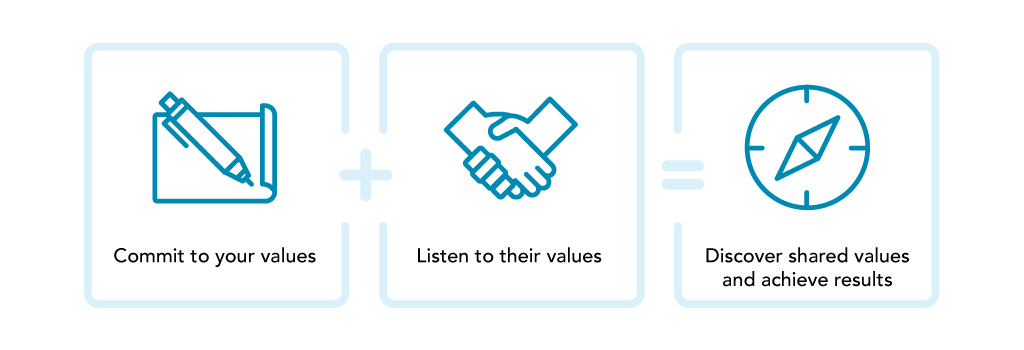
Exemplary Leadership Starts With You
Jun 16, 2021
It is a common misconception that leadership is innately tied to a title; that simply because someone is promoted to a prestigious position, the respect of their colleagues will automatically follow. However, as we have all likely experienced (from either perspective), that is not always the case. True exemplary leadership is developed through the consistent practice of behaviors and skills that start from somewhere unexpected…within yourself.
In the best-selling book The Leadership Challenge®, James Kouzes and Barry Posner outline The Five Practices of Exemplary Leadership® and how they create a framework for the development of exemplary leadership, starting with the first practice, Model the Way.
To effectively Model the Way, you must start by clarifying your own values. When assessing what kind of leader you want to be, the first step is to look in the mirror and answer the question: who am I?

Next comes authenticity. It is easy to look to established leaders as a guiding example for what all leaders should be, but it’s important to take the time to explore your own communication style. People are drawn to authenticity, and when your people know that you are speaking and acting from your heart, your values, and your experience, they are more likely to see you as a leader.
However, leadership is not only about your values. After all, an organization thrives when all are committed and engaged, and it is important to remember that your people’s values and beliefs are their driving force. When you create space for everyone to explore their own belief systems, you will model commitment to the common cause because everyone is able to stay true to their beliefs and be valued for the diversity and perspective they bring to the organization.
Of course, what creates real success in the workplace is the space where you and your people align your values for a common cause. Shared values are the foundation for building productive and genuine working relationships. Creating an environment of camaraderie and respect involves everyone getting comfortable with sharing, starting with the leaders, whether it be about the kind of work they enjoy doing or what their favorite food is. The more you model vulnerability and authenticity by getting to know the people you work with and what matters to them, the more easily you will be able to reach your full leadership potential and achieve results.

Once you have clarified your own values, found your voice, and inspired commitment through camaraderie and connection…what’s next?
It’s time to set the example! Be an example in your organization for the kind of behaviors you want to nurture. People look to leaders to see if they are, in fact, walking the walk. As Kouzes and Posner say in the book “The power of the leader’s personal example can’t be stressed enough. Researchers find that leaders who persist in attaining organizational goals, promote the organization to outsiders and insiders, and initiate constructive change in the workplace are much more likely to have direct reports who exhibit the same behaviors than leaders who don’t set that kind of example.”
Exemplary leaders understand the power of their words. How you speak about the people in your organization, your client base, or your audience can quickly and effectively paint a picture of how you think of the world and your position in it. “The words people choose to use are metaphors for concepts that define attitudes, behaviors, structure, and systems,” the authors say. Choose your words wisely, and others will follow.
When you take on the responsibility of leading by clarifying your values, aligning with your organization, and setting an example to Model the Way, you are well on your way to becoming an exemplary leader.

The Leadership Challenge, Copyright © 2017 by James M Kouzes and Barry Posner
In the best-selling book The Leadership Challenge®, James Kouzes and Barry Posner outline The Five Practices of Exemplary Leadership® and how they create a framework for the development of exemplary leadership, starting with the first practice, Model the Way.
Who Are You? Clarify Your Values
To effectively Model the Way, you must start by clarifying your own values. When assessing what kind of leader you want to be, the first step is to look in the mirror and answer the question: who am I?
Next comes authenticity. It is easy to look to established leaders as a guiding example for what all leaders should be, but it’s important to take the time to explore your own communication style. People are drawn to authenticity, and when your people know that you are speaking and acting from your heart, your values, and your experience, they are more likely to see you as a leader.
Model Commitment to Your Values
However, leadership is not only about your values. After all, an organization thrives when all are committed and engaged, and it is important to remember that your people’s values and beliefs are their driving force. When you create space for everyone to explore their own belief systems, you will model commitment to the common cause because everyone is able to stay true to their beliefs and be valued for the diversity and perspective they bring to the organization.Of course, what creates real success in the workplace is the space where you and your people align your values for a common cause. Shared values are the foundation for building productive and genuine working relationships. Creating an environment of camaraderie and respect involves everyone getting comfortable with sharing, starting with the leaders, whether it be about the kind of work they enjoy doing or what their favorite food is. The more you model vulnerability and authenticity by getting to know the people you work with and what matters to them, the more easily you will be able to reach your full leadership potential and achieve results.

Once you have clarified your own values, found your voice, and inspired commitment through camaraderie and connection…what’s next?
Set an Example
It’s time to set the example! Be an example in your organization for the kind of behaviors you want to nurture. People look to leaders to see if they are, in fact, walking the walk. As Kouzes and Posner say in the book “The power of the leader’s personal example can’t be stressed enough. Researchers find that leaders who persist in attaining organizational goals, promote the organization to outsiders and insiders, and initiate constructive change in the workplace are much more likely to have direct reports who exhibit the same behaviors than leaders who don’t set that kind of example.”Exemplary leaders understand the power of their words. How you speak about the people in your organization, your client base, or your audience can quickly and effectively paint a picture of how you think of the world and your position in it. “The words people choose to use are metaphors for concepts that define attitudes, behaviors, structure, and systems,” the authors say. Choose your words wisely, and others will follow.
When you take on the responsibility of leading by clarifying your values, aligning with your organization, and setting an example to Model the Way, you are well on your way to becoming an exemplary leader.

The Leadership Challenge, Copyright © 2017 by James M Kouzes and Barry Posner

